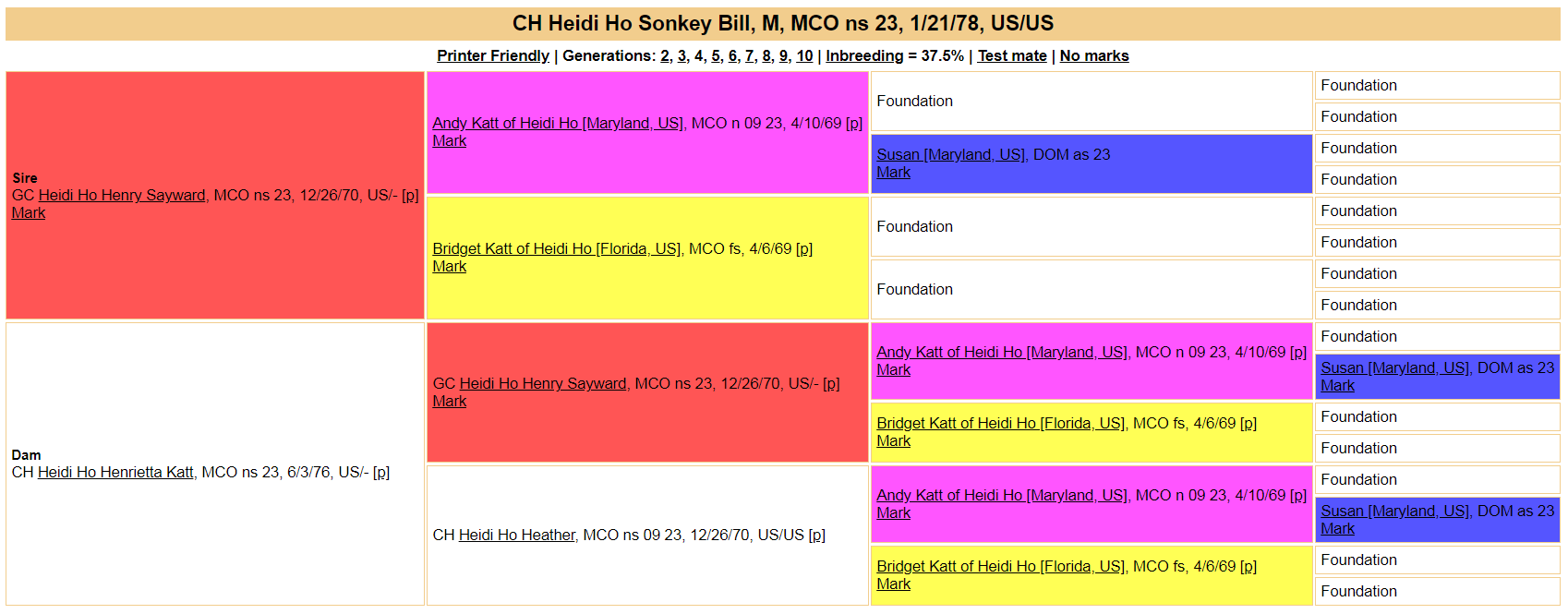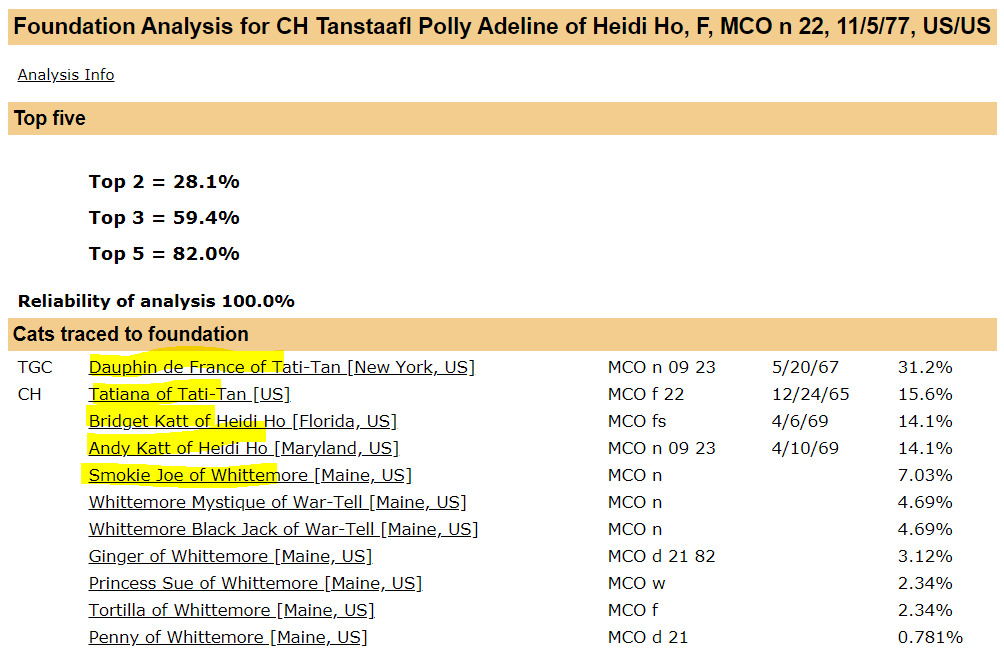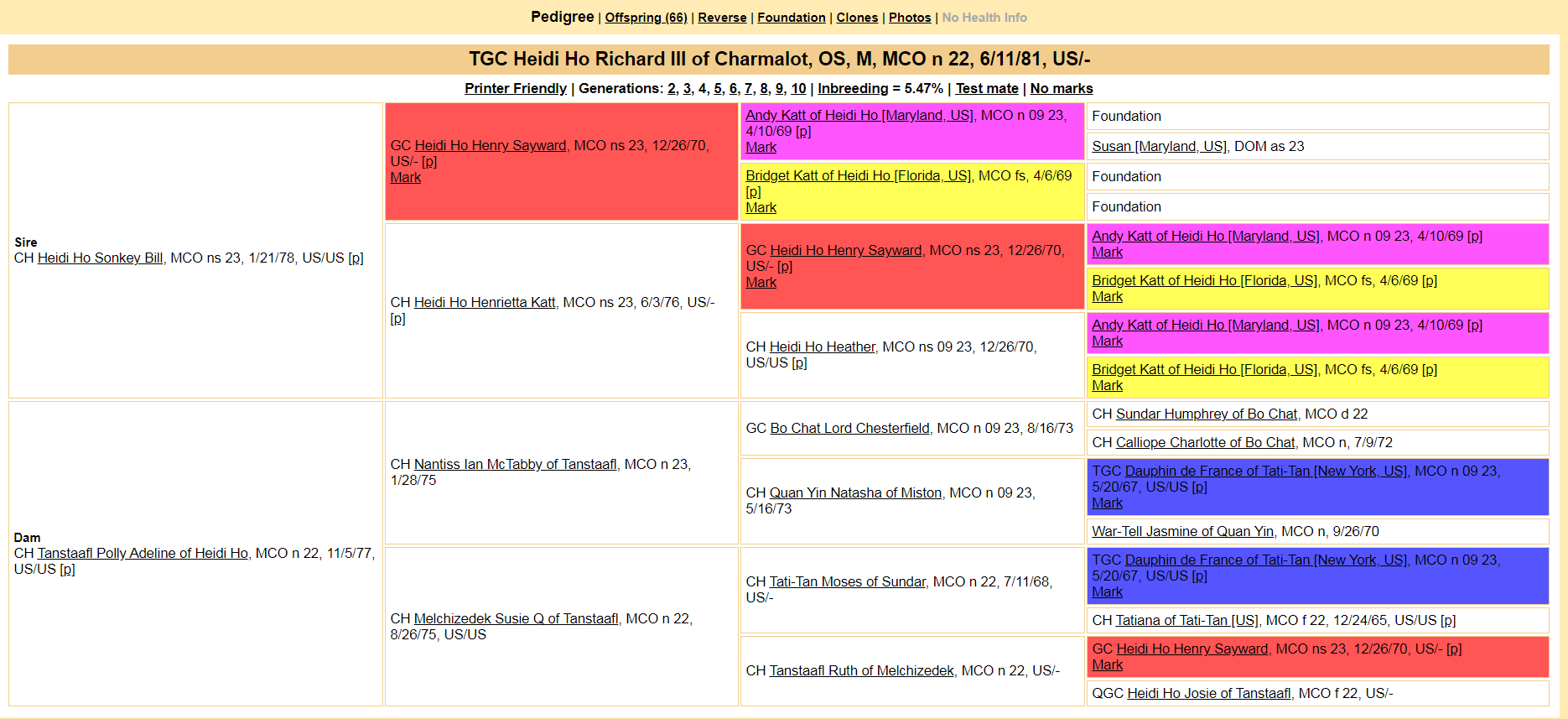- Details
- Hits: 3967

Foundation Breeding Myths Debunked
- Do you prefer foundation cats coming only from farms? You might not be aware of this fact: Farmers in North America regularly have their cats killed by either commercial vehicles, farm/wild dogs or coyotes, cougars, raccoons, fishers (large birds), etc., every so often. These same farmers then either get kittens from neighbours or search local newspapers, in order to start re-building their much needed “farm colony” that will serve them to keep rodents under control. There are very few old farm lines out there. Registered Maine Coon mix? Likely no - possibly yes.
- Foundation cats can’t be typey? Can they ever be! Fact is there are even DOMESTIC short haired and DOMESTIC long haired cats with large ears, lynx tippings, fat, long muzzles, long and heavy bodies, long tails and even chins! :-) Usually, they don’t display ALL those traits but many have some of them. Registered Maine Coon mix? Likely no - possibly yes.
- There must be something ‘fishy” with good looking, early generation foundation cats? Fact is when a foundation cat is bred to another foundation cat, it is VERY possible to achieve good results. The person must chose the initial population as fine quality, and, aside from trial and error, must have “breeder’s eye“, in order to even out weaknesses. Related or not related won’t matter at all. Why? Because genes DON’T care one bit about relation. They just act "technical" and tell the cells what to do. Of course we don't know how many years it will take for each individual line to achieve the desired quality, the point is that it IS possible, no matter what critics say. Someone once said to Phyllis Stiebens of Behold/Kumskaka: “Too good of foundation cats should not be used, as they might actually be pedigreed MC’s, let loose.” Her response was: “First of all, there are zero breeders who toss their breeding cats outside when finished. Second of all, why would we look for a non-looking Maine coon cat? Doesn’t that defeat the purpose of trying to find one to breed with? Think about that, if we get a roman nose cat, or a short stocky cat, or a cat with fine, frail boning and thin sparse coat, WHY would we want to add those to our cats? The goal is to find MC LOOKING cats to breed with, anywhere in USA or neighboring Canada - Nothing else.” Well said!
- A rescue cat from a rural veterinary clinic or a rural shelter is likely a registered Maine Coon mix? This depends on where one lives. What a lot of Europeans aren’t aware of is that North America and especially Central and Northern Canada has many sparsely populated areas and sometimes hour- long stretches of bush or grassland, with the odd farm in sight. There are often absolutely no breeders around, for a radius of anywhere between 200 and 1000 km. In fact, people would chuckle about you in some of the little towns if you told them you breed pedigreed cats. I remember literally being the “laugh of the town” with my “foundation projects” in the 90s. Does this give people a free ride to just register "any old" rescue cat and call it a Maine Coon and be done? Of course not! A shelter is definitely NOT a place where most of us would aquire our foundation cats - for several reasons. But this needs to mentioned here, for the sake of the article. The criteria for ethical foundation breeding have not changed. This is why we have different articles written, on how to start a foundation line properly and carefully. Registered Maine Coon mix? Likely no (depending on location) - possibly yes.
- “Find me in the River”? Fact is that lots of us think Maine origin cats are cool! For the sake of the article though, I’d like to mention that I was told on the phone by a couple of breeders from the State of Maine that is not uncommon at all to use the local newspaper to get new foundation cats. This is solely a matter of preference, and I don’t judge anyone in Maine or the rest of North America for doing this. This article isn’t about ‘beating the dead horse‘ origin debate. It has, however, become literally next to impossible to find wild roaming cats anywhere in North America - mostly because of animal rightlers who snatch them up, spay them and place/sell them. Registered Maine Coon mix? Likely not, possibly yes. Things that once mattered to me a long time ago now simply make me feel “nostalgic”. What REALLY DOES matter though with this *North American breed* is that the foundation cat is healthy, sweet tempered, decent looking and not related to my pedigree!!
- An F2 foundation x show line offspring has to look like a mongrel or Persian mix? Veggie tales! Have we got a show for you.....Fact is if you breed a good quality foundation cat to a well bred show cat, meaning that show cat has homozygous quality consistency in the background (where two identical alleles are carried for desired traits), you can literally get early generation cats that can be shown in championship class! I have championed some of my F2 cats, just did not receive the actual title. Obviously people won't produce GC or RW until higher generations. Having said this, litter consistency is the key! This is something I learnt along the way from Julie Spayde of Koontucky MC. Of course this is something that can’t always be applied in early foundation generations. It is one of several reasons though why I always prefer, but haven’t consistently used, a group of farm cats. You can see and study the whole litter, relatives and sometimes even their history.
- Did you know when cats in your breeding program are beginning to get smarter, when you start experiencing a higher fertility rate, larger litters with a lower death/deformity rate and lower irritability in your kittens it is a GREAT sign that you have likely just introduced an unrelated, new foundation line into your program ? The blessing of course mostly (not always) lies in the “act of outcrossing”. The Maine Coon cat was registered as a Natural (this means naturally occurring), North American breed!
- Can we ever be 100 % sure about the actual breed or background of a Maine Coon foundation cat? Of course not! None of the foundation breeders I have worked with would ever make a pretense about this or claim to be perfectly sure about this. Now we have a gene test available on Optimal Selection. The test neither shows how much % of which breed the cat is, nor does it tell you who the ancestors are, or from which breed at all. It compares the genes of the tested cat to the other tested cats, being placed as “dots“ on a “map“. This allows you to see "clusters" of cats who are genetically related. You can find out how related the foundation line is to your registered Maine Coon. You can also see the genetic diversity of the individual cat. Participacting cats are marked with a different color for each country. It’s an interesting tool - a tool that has already proven some foundation lines to be authentic. F1 or F2 cats that might have been previously classified as "fishy" were finally able to receive their due credit. (Most of them do like fish though).
- Did you know that most of the newer foundation cats in our pedigrees and their breeders have done a GREAT service to our breed, in regards to longevity, overall health and especially also temperament and intelligence? Please DO have your own taste, please DO purchase or find them wherever you like (in the river if you please). There are charlatans in every breed section. Please do, however, have some manners and stop downgrading, or, in some cases, even slandering other ethical breeders who have different opinions from yours! You are doing the breed, your fellow breeders, and even yourself a great disservice. Remember that gossipers are usually unhappy people. Ulrika Olsson of Ylletrollets said it well: "If we explode among ourselves, this will enable the highly inbred, overtypified Maine Coons even more to take over."
- Last not least, did you know that a large amount of the breeders who are educating others on public lists on how and where foundation breeding should be done are actually the same people who have never really gone through the actual “act” of true foundation breeding - the real stuff? I think that most of them are doing a fantastic job, regardless!
- Details
- Hits: 3289
This is a studie about the longterm inbreeding of our Maine Coon.
I wanted to find out how it is within our breed today, so I collected information from the PawPeds database. I collected data for all Maine Coons born in 2019.
I selected and removed all cats that had more then 10% that could not be traced back to foundation. I also collected data for all Norweigan Forest Cats and Siberian born in 2019.
Those three are so called nature breeds, which means that they are not created breeds or so called designer breeds.
We all know that we in our breed have a big bottleneck caused by those 17 siblings we call the clones. We know that many cats got high values, but we do not know exactly how it looks in comparison to those we call outcross, thosw with lower values (below 20% in clones).
First of all, I collected all the data, after this I sorted the data and created diagrams to make it more visually.
COI in this article is the total inbreeding traced all the way back to foundation, where less then 10% information is missing in the pedigree, keep this in mind when you look at the diagrams and when it says only COI.
Below you can se a diagram showing the COI (complete inbreeding back to foundation) against the Clones for the collected cats (MCO).
I will start with a diagram showing the COI versus the Clones for the collected cats.
As you can see we got the biggest cluster in the percentage 33-37% in clones here are the largest number of cats today.
You can see that those also are in the area of 13-20% percent in COI. The outcrosses the ones below 20% in clones are all located in the 5-10% area.
The clones versus the COI, the percentage in the vertical is the clones and the percentage in the horizontal is the COI from all the collected cats.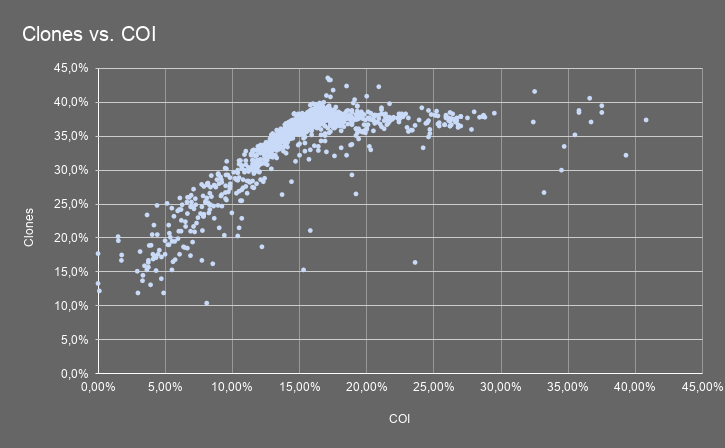
I also had a look within the Maine Coon breed if you take all the numbers for the collected cats from 5 generations, COI and the Clones, and put them in a Diagram to have a better overview of them. This is what it looks like.
In the vertical you got the percentage of the COI and the Clones, on the horizontal you got the number of cats.
You can see that how the inbreeding on five generations is being at the very bottom with just a few exception here and there.
The Clones and the COI however is following eachother very closely, with a few exceptions. But also here you can see that cats considered outcross with 20% or lower Clones (we can also look at foundation, but I did not do that in this article, maybe that is something for another project).
The reason why the clone serie is going straight and the others are moving up and down is because I sorted the cats in order from low to high in clones.
Since every cat got it's own numer the other series is going up and down following each cat.

The next thing I did was to compare Maine Coon with the other two natural breeds Norweigan Forest Cat and Siberian.
This is where it becomes really interesting. While almost 80-90% of the Maine Coons are in the range of 15% or higher, the Siberian are mostly below 10% in COI at most around 11-12%, the Norweigan Forest Cat is mostly below 5% in COI
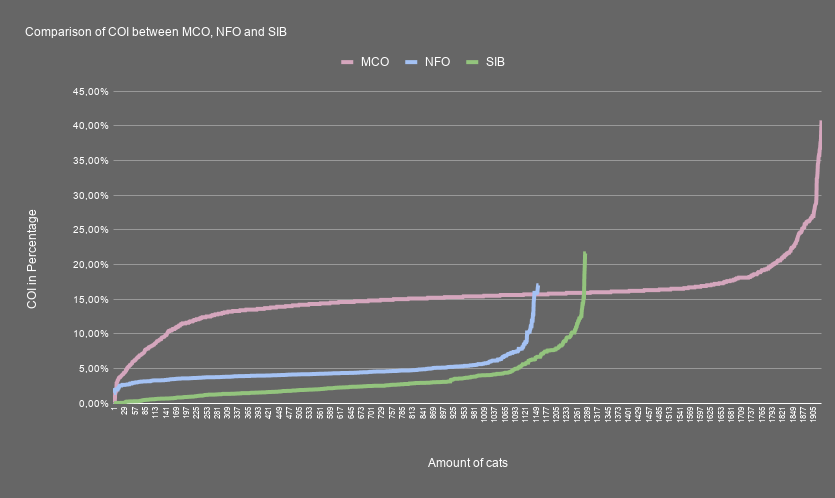
I also did a comparison between the Clones for the Maine Coon breed and the single cat Pans Polaris for the NFO. My thought is to extend this analyze in the future and look back in history to see how the development looks if I would compare those two breeds.
As you can see they are far below, the MCO has somehow normalized at about 35-40%, while most of the NFOs are between 10-15%.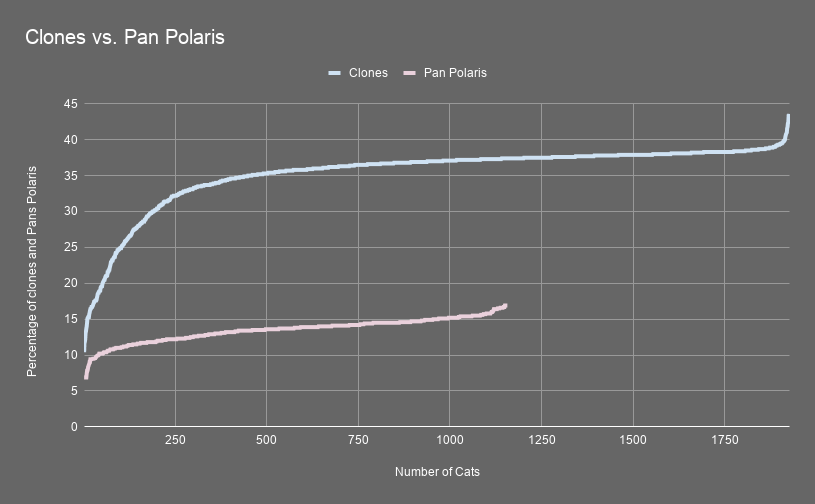
I also had a look a bit deeper and separated the cats in groups depending on the clones.
The first group are the ones below 20%, those are the cats considered outcross.
Vertical is the percentage of the clones and COI, horizontal is the number of cats.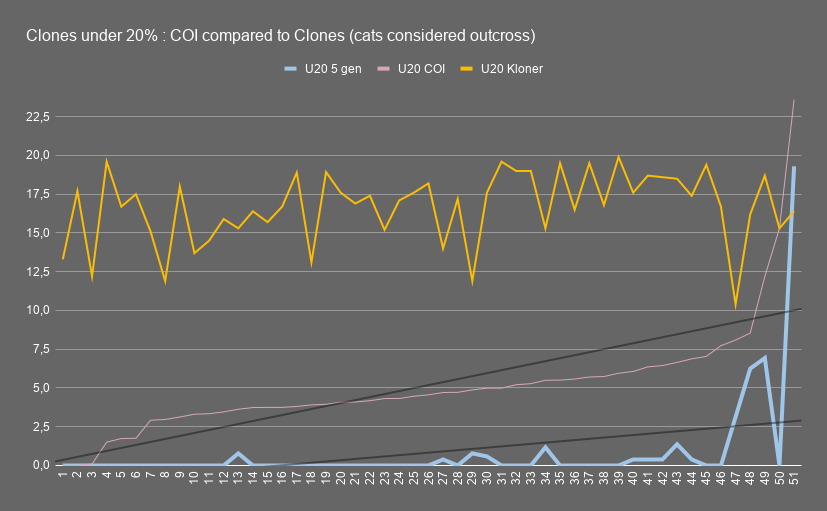
Next group is the cats between 20-30% in clones. Same here, vertical is the percentage of the clones and COI, horizontal is the number of cats.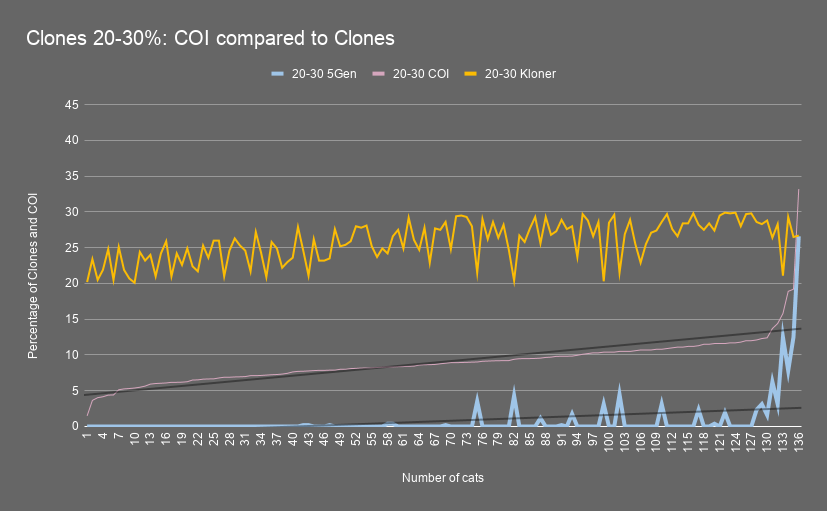
Next group is the cats from 30 to 35% in clones, also here vertical is the percentage of the clones and COI, horizontal is the number of cats.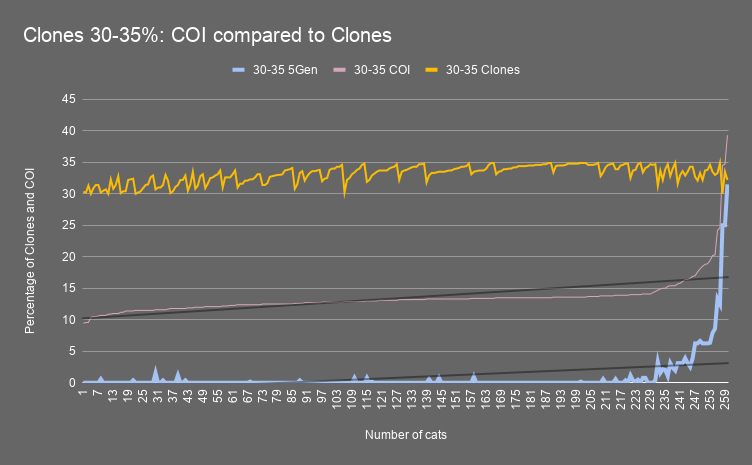
And at last, we have the cats from 35% and up, same here vertical is the percentage of the clones and COI, horizontal is the number of cats.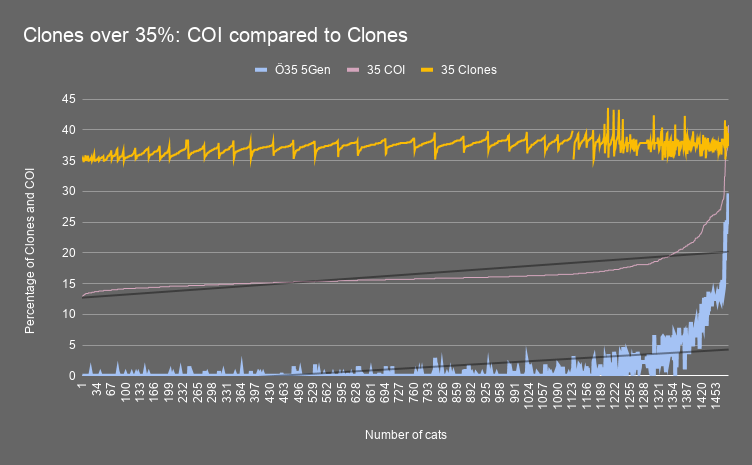
As you can see pretty clearly when looking at those diagrams the COI does go up when the clones do, so the clones absolutely affect the inbreeding of our breed even if they were born 40 years ago.
At last a diagram showing the COI for the four different groups.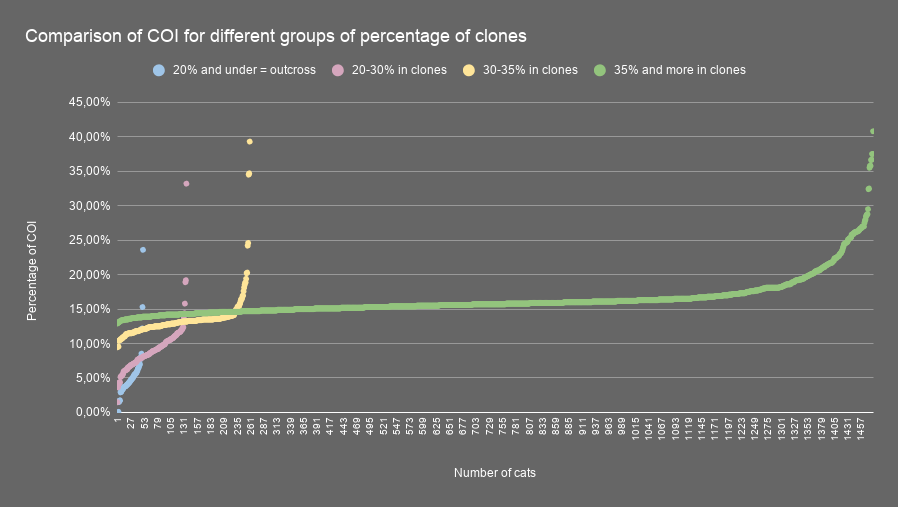
By: Malin Sundqvist
- Details
- Hits: 4480
Search, find, and work with New Foundation
As we all know the Maine Coon was founded in Maine and spread all over the US and also CA.
When we are looking for new blood to add to the breed nowadays, it’s important to know what to look for and what to avoid. When we are looking for new bloodlines the reason is to try to lower the genetics from the 17 siblings we know as the clones first and foremost. Therefore it’s really, really important that we can be as sure as possible that the cat we take in as New Foundation has no trace of purebred behind, but also that it's as healthy as possible.
In this article, I will write “New Foundation” - “NF” in short most of the time.
Search and Find
We do need to document carefully, as much as possible, of course, we cannot know everything. But we can make sure to document a lot.
What farm did the cat/kitten come from? (We should be careful use stray cats OR cats found in yards in suburban areas or cats found at shelters, since we have no clue, for all we know this cat/kitten could be a purebred that got lost, or a cat/kitten from two registered parents but who was breed by someone who does not have a cattery and does not bother to register their kittens. Which means those can very well be from a purebred background.
Earlier MyCatDNA/Optimal Selection had a very nice function, see below, that we could use, but they have removed it after the update.
Look at this picture, the little black dot with an X-mark with a red arrow is one of my females with really high genetic diversity, she is on the outer edge of the clusters and very unrelated to many other cats.
If you look at the black arrows you can see those cats are far away from the cluster in the middle, they are very unrelated cats and here somewhere is where you would suspect to find an NF you are testing if it’s closer to the cluster, well then you got your hands on a cat that most likely got a lot on MCO in it and as an NF it’s not worth much.
Who is the mother of the Cat/kitten?
The owner should at least know the mother of the cat/kitten.
Is there a particular male who hangs around that could be suspected to be the father, or have they seen any male lurking around that could be the father, for example cat from a neighbouring farm, etc.
What other cats are moving around in the areas?
Document as much as you possibly can with photos, questions to the owner of the farm.
The more information there is, the better it is. If the farmer can share information on several generations, that's even better.
Maybe the mother has both her mother and grandmother on the farm.
More documentation
If you are not living in the US yourself and are finding a New Foundation by yourself, make sure to publish proof of origin!
Such as Travel documentation, all the documentation signed by the veterinarian in the USA, making sure to get as much documentation as possible, photos from the original home, with the mother of the kittens, siblings, and all those kinds of things. It's not hard at all to show your cat's origin, this is something that is easily done by anyone who imported a cat.
Before travelling to Europe, the kitten you found, of course, needs to see the veterinarian several times, get two shots, get tested for FIV/FelV, full blood panel, get Flea treatment, get a chip, get a veterinary clearance, and get the passport. Just show all this kind of documentation, and then there is no need to question the origin of this cat.
A small warning, today with AI and all those things, falsifying a document can be very easily done if you are sent the documentation in a picture. If you have any doubts, please contact the veterinarian in question to make sure this cat was in fact there. Also, check the travel documentation to make sure it's legal.
Work with New Foundation
Today, we need a LOT of New Foundation lines to help the breed become healthier and stay healthy. This means that we all need to help each other, just getting an NF yourself and mixing it with your own show lines that have a really high COI above 10-15% is not helping the bigger picture.
You can still register for F1 with ACA. Below is an explanation of what F1 to F5 means.
An F 1 is a first-generation Maine Coon foundation cat. This cat can be found in the wild, on a farm, or can be obtained from a private home or shelter. None or only one parent of an F1 is known and registered.
F1 - Is a first-generation Maine Coon foundation cat, none or only one of the parents of an F1 is known and registered. Those cats might have been found in the wild, on a farm, or obtained from a private home or a shelter.
F2 - Is a second-generation Maine Coon Foundation cat, both parents are known and registered but behind them, one or both are F1 (see above).
F3 - Is a third-generation Maine Coon foundation cat, both parents and grandparents are known and registered, but one or all of the grandparents are F1 (see above), one or more of the parents are F2 (see above).
F4 - Well, you see what this leads here, the F1 cat will be found in the fourth generation.
F5 - This cat now has a full pedigree and the F1 cat/cats behind it will show first in the fifth generation.
I will explain why if you look below.
When you find an F1 to work with, think carefully about what you are doing. I read a quote a long time ago.
If you think of the existing gene-pool (the show lines) as a glass of water, and the NF-cats are blueberry essence to give the water taste and colour.
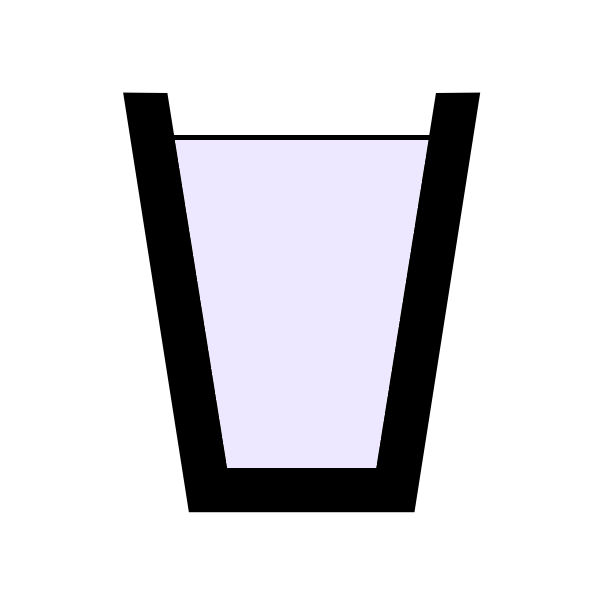 |
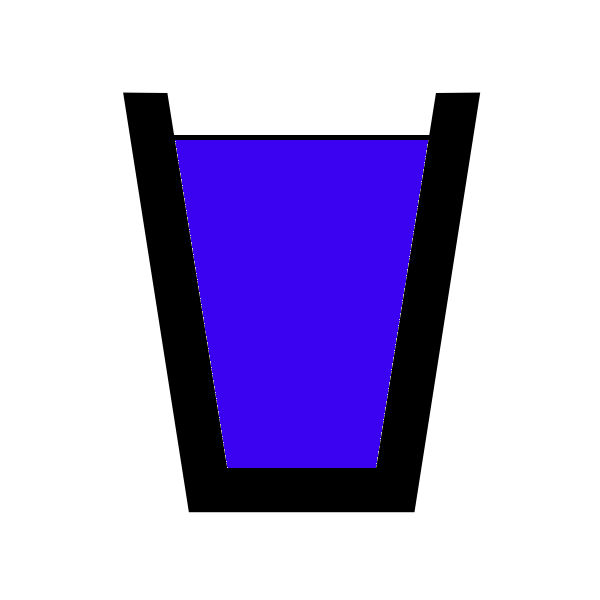 |
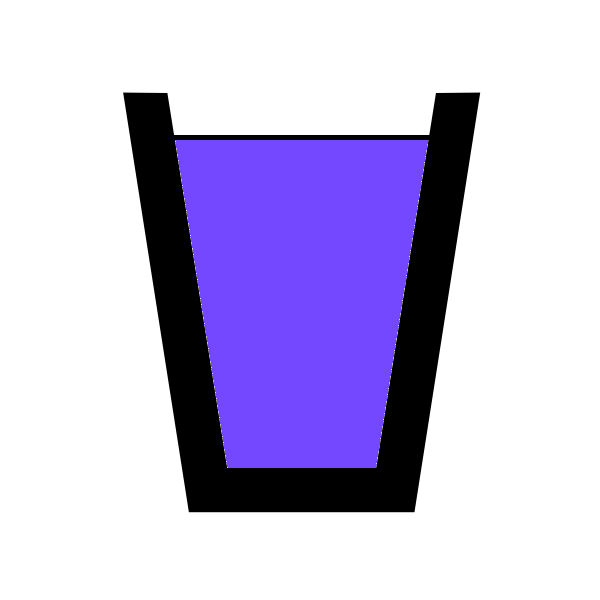 |
 |
 |
| At first, you got the normal population of MCO. Without any NF added, just pure water. | Then you add a bit of blueberry essence, and you get a nice color and a good taste. | After this, you continue to add another glass of water to the mix, and the mix will be a bit paler and less tasty, a bit flat. | Then you add yet another glass of water, now the color is visually paler and the taste is really flat, almost gone. | You then add yet another glass of water, and the essence will be almost non-existent, everything from the essence you put into the first glass would be almost gone, diluted into nothing, it would get lost in all the water. |
This scenario above is what happens if you add a new foundation to the existing population and then keep adding show lines over and over again; all the work you put into a new foundation would be for nothing!
If you get an F1 but then continuously keep mating it to the existing population instead of breeding, keeping it dark blue and tasty, you might add some water, but then you add a bit of essence again, add water, and then essence. You get more essence you can easily mix the essence with essence (mate NF with NF and NF to Outcross to build new breeding lines with NF).
If you do get a nice NF line, make sure to spread the kittens, in normal cases we never let more than 1-2 kittens go to breeding from a litter, in those cases, we might rather let more kittens go to breeding but make sure that none of them gets too many litters each, and also that the lines are spread around the globe so that some are in the US, some in the south of Europe and some in Northern Europe and so on…. It's better to have more NF cats than to overuse a few.
There is a lot of work involving breeding NF-lines but it’s worth it in the end. A lot of breeders in Europe are in desperate need of NF-cats, but they are hard to get these days.
A lot of breeders who worked with NF are nowadays mixing them with show lines, what we want and need are pure NF-lines and pure NF cats without show lines behind.
Health
One thing that is of the highest importance is to really, really test both our new NF cats but also their offspring and the offspring after that so that we quickly react IF we discover some unwanted trait.
First of all, of course, you need to do a full bloodwork, look for all kinds of sickness like FIV/FelV, an eye-packed to check for viruses and other diseases, you need to make sure there are no fleas, and so on.
- Full DNA Screening by MyCatDNA/Optimal Selection - You've got to know ALL possible diseases to see if the cat/kitten might carry something known in another breed or in the MCO.
- Make sure to do the X-ray at 10 months within the health program (everyone can easily test within the health program since any veterinarian is allowed to perform the X-ray and send it into the health program).
- Check for patella also when doing the X-ray; we can never be too careful.
- Make sure to do heart screenings to check for HCM at 1,2,3 and 5 (if you are able to find a veterinarian connected to the health program that is the best, but if you at least do the test and/or if possible get your veterinarian to apply to be connected to the health program).
- When doing the first HCM, also check for PKD just to be sure.
Do not forget that when you had the first litters that we should also make sure the cat is fit as a breeding male/female in all other areas, like for example.
- How is the temper?
- Do the kittens have normal birth weights
- Are there low neonatal mortality rates
- Does she have easy births
- Does she have normal milk production
- No signs of cannibalism or abandonment
By: Malin Sundqvist
- Details
- Hits: 3222
Within the Maine Coon breed we talk about the clones or the clones percentage. But what is meant by this exactly?
When talking about the clones, we are talking about the 17 descendants of Tanstaafl Polly Adeline or Heidi Ho (Polly) and Heidi Ho Sonkey Bill (Sonkey) born between 1979 and 1982. The reason that they were given the name "clones" is because the kittens looked exactly the same. Just as if they were copies of each other, painted with a different color. These comments were also made when the breeder presented her first litter at a show. Because of this the label "the clones" has remained. Both parents got champion titles added to their names and their first growing kittens did very well on show also. This made the clones in the early 1980's very popular. The similar look of the kittens was very desirable at the time, because the predictability of future good showresults made them very attractive for other breeders. Sonkey and Polly together had 7 litters. From these litters, 17 kittens were used into breedingprograms. Below you can see a screenshot from Pawpeds of the clones. The first colums shows that many of them have indeed obtained their showtitles.

Many of these 17 clone brothers and sisters can still be found in the pedigree of the Maine Coon of today. Nowadays a Maine Coon has a clones percentage of 35% on average. This means that 35% of the pedigree of this cat consists of the clones from 40 years ago. Sometimes the clones can be found more than 70 times in the family tree.
Sonkey - the father of the clones

Two children of Andy and Bridget were mated (Henri Sayward and Heather, brother and sister). A daughter of that combination, Henrietta, is again paired with her father (Henri Sayward). Sonkey was born as a result. Sonkey's father is also his grandfather and Sonkey's grandmother is also his aunt. Andy and Bridget are both his grandfather and grandmother on father's side, and twice his great-grandfather and great-grandmother on mother's side. Sonkey therefore has an extremely high total inbreeding coefficient of 37.5%.
Sonkey had 42 offspring (including the 17 clones). Sonkey also became a grandfather of 404 grandchildren, of which 225 related to the clones. The other 179 grandchildren of Sonkey are from female partners other then Polly. Those 179 offspring obviously have a clones percentage of 0%.
In his pedigree you can see the double ancestors in the same color. This is a pedigree that most breeders will avoid at all times. Still, Sonkey and his clones are found in almost all of the Maine Coon family trees today. Can you imagine that when a cat that has 35% in clones, the pedigree consists for 17,5% of father Sonkey, who is the result of a father - daughter mating, where the daughter is the result of a brother - sister mating. It makes you wonder...
Polly - the mother of the clones
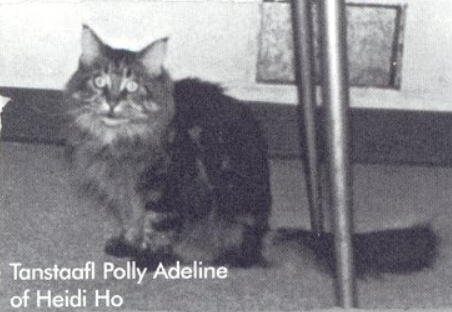
Polly's (Tanstaafl Polly Adeline or Heidi Ho) pedigree consists of fewer inbreeding matings than those of her partner Sonkey. Her total inbreeding percentage is 7.81%. Half of her mother's line consists of Andy and Bridget. But Polly's pedigree also contains the three other foundation cats, which together with Andy and Bridget form the top 5 most common foundation cats. Polly's pedigree consists of Dauphin de France or Tati-Tan for 31.2%.Thanks to Polly, Dauphin is number 3 of the top 5 most common foundation Maine Coons. Followed by Tatiana at number 4 and Smokey Joe at number 5.
The 17 clones
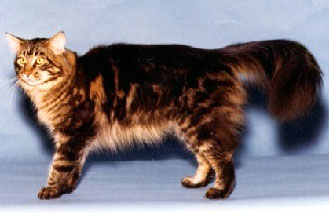 Let's take a closer look at the pedigree of these 17 clones; the kittens of Sonkey and Polly.
Let's take a closer look at the pedigree of these 17 clones; the kittens of Sonkey and Polly.Their inbreeding percentage over 4 generations is 5.47%. And the total inbreeding% is 9.38%. The top 5 foundation cats is 91%. You can see by this high percentage that a high clones percentage automatically means a high top 5 percentage. In fact, this means that the top 5 percentage is AT LEAST 91% of the clones percentage. Example: when a Maine Coon has a clone percentage of 40%, the top 5 percentage has to be at least 36,4%. The other way around you can't predict the height of the clones by looking at the top 5. The top 5 had offspring creating different lines then the clones. In theory a Maine Coon can have a top 5 % of 70% and a clone percentage of 0%. These lines weren't used as much as the lines of the clones and therefor those lines are very rare or maybe even died out.
The most counted ancestors of the clones (also called top 5 foundation):
Number 1 and 2: Bridget Katt of Heidi Ho (Bridget) and Andy Katt of Heidi Ho (Andy) are counted evenly in the pedigree and together are 64,1% of the pedigree of the clones
Number 3: Dauphin de France of Tati-Tan is 15,6% of the pedigree. The total of the top 3 together is 79,7%.
Number 4: Tatiana of Tati-Tan is 7,8% of the pedigree of the clones.
Number 5: Smokie Joe of Whittemore is good for 3,52% of the pedigree of the clones.
The total of this top 5 is 91%.
Now you understand where the top 5 foundation cats came from. The use of the clones in many breedingprograms created this top 5. You will also understand why it is not just a top 5, but the top 3 and top 2 is mentioned separately. There is a big difference between the 32% of Andy and the 3,52% of Smokie Joe.
The impact of the clones today
Because the clones were born about 40 years ago, it is not something that every current breeder takes into account. The clones are mostly no longer visible in the last 10 generations. Many breeders are therefore not aware of their impact today. The volunteers of Pawpeds have therefore developed the possibility to calculate the clones percentage for each Maine Coon. This way you can see exactly what percent of your cat's ancestors consists of the clones. To see this percentage, click on the "clone" link at the top of the family tree in Pawpeds.
The development of the clones
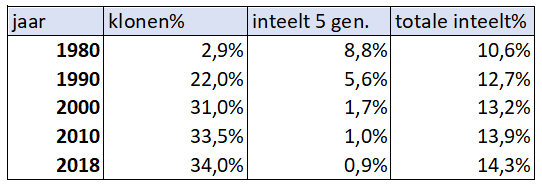
In addition, a Maine Coon with a high clones percentage automatically also has a high foundation top 5 percentage (the 5 most common foundation cats). Only a small percentage of ancestors remains where unrelated ancestors and unrelated genes can come from.
In the 80's there were many other lines that were used for breeding apart from the clones. Unfortunately, the clones were so popular in that period that many breeders sooner or later added an offspring of the clones to his or her own breeding program. Old lines with a low percentage of clones can therefore hardly be found today. The lines that do have a low clones percentage are mainly the lines to which a New Foundation Maine Coon has been added. By adding new blood to the breeding program, the clones percentage can be drastically reduced.
Why low clones is more important than low inbreeding or a low top 5
You may understand that if the current population has an average percentage in clones of 35% or higher, this will result in severe narrowing of the gene pool. The necessity is therefore high to breed with Maine Coons that are as unrelated to these 17 clones as possible.
The clones, top 5 and inbreeding percentages are linked to each other. The higher the clones percentage gets, the higher the Maine Coons parents are related to each other. As explained above, the clones have the top 5 most common ancestors behind. This top 5 will increase together with the increasing clones percentage. The average top 5 foundation percentage is 70% nowadays.
With an increasingly higher clones percentage, the average inbreeding percentage of the population also rises due to their connection to each other. It will then become increasingly difficult for a breeder to make low inbreeding combinations in the future, because there are fewer and fewer unrelated lines to be found. The table shown and discussed above shows this trend well.
The lines that are still low in the clones are often mixed too quickly and too much with lines that are high in the clones. This is often understandable from the point of view of that one breeder. A breeder wants to achieve his own breeding goals and compensate for the weaker points of the line. After all, there is a lot more availability in the population of high clones lines to find the perfect cat to complement your breeding program. However, the total population of the breed would be better served by pairing lines with low clones to other unrelated low clones lines. This increases the amount of cats that are low in the clones. This helps the total population to a higher genetic diversity. In the future this will result in more opportunities of continuing to make low inbreeding combinations. If there are more low clone lines available it will also make it possible for breeders to reach personal breeding goals and work on a higher diversity at the same time.
In summery: low inbreeding is important for short term health, but a low clone percentage helps to keep a high genetic diversity of the breed in the long run.
Low clones - breedingprogram
In the Netherlands there are very few outcross breeders (who breed with a clones percentage below 20%). Of the hundreds (400-500) Maine Coon breeders in the Netherlands, probably around 3-5% focus on outcross. The Netherlands is no exception here, because this trend is visible worldwide.
With this article I hope to create more awareness about the clones among breeders, so that more breeders want to make this a priority in their breeding program. Not everyone can or wants to work with outcross. It can't even be possible for every breeder to work with outcross, because unfortunately there are too few outcross Maine Coons available due to these trends. But every breeder can take the clones into account in his or her breeding program. Even if it is only a few percent per mating or for every new cat that you buy, every small step helps the breed to a lower clones percentage and higher genetic diversity.
By: Debbie Sprenger
You can find more interesting articles about the clones here:
- Interview with the breeder of the clones, Beth Hicks
- Article about the clones and foundation cats and their history
- Details
- Hits: 3160
Outcross
When we talk about Maine Coon, we talk about clones and new foundation/novice, but also outcross. What is an outcross?
In order to be called an outcross, a cat must meet at least one of the following criteria:
- 50% or less of the top five cats (average 65-70%) or
- 35% or less of the top three cats (average 50-55%) or
- 25% or less of the top two cats (average 35-40%)or
- 20% or less of the clones (average 30-35%)
Note that outcross is not the same as New foundation; a cat might be seen as an outcross without beeing New foundation.
We often also call these cats just foundation. Actually, this is kind of wrong since it’s New foundation we are talking about, the cats who initially laid the foundation for the breed itself are actually the ones called the foundation.
Now, when we bringing new blood into our breed, these will become New foundation. Working with outcross is incredibly important for our breed, but unfortunately today there are two groups of breeders the ones who work with outcross and New foundation only and strive to get as low values as possible and the ones who do not give it a single thought, working with show lines maybe doesn't even know what this means. Originally, however, a New foundation was taken in, to breed out our high-cloned cats and bring down their values. This seems to have been forgotten by some breeders today.
When it comes to my own breeding I do vary a lot, I have always done, I have often had a bit higher (but not sky-high values because of the risks they bring) but something higher together with some lower. I have often lent out the lower studs I have had. To help lower the clones in females owned by those who show that they are really interested in lowering the value of their cats, not just say so to be able to borrow a nice outcross male.
We should all work together here, everyone should work with outcross in some degree, it does not mean everyone has to work with a New foundation and really low values in clones, but we should definitely work together to bring down the values within a few years, so no Maine Coon has such sky-high values as they have today. Where the limit goes for what makes sense is terribly hard to say, but when they fall over 35% in clones, it's definitely too high and the inbreeding depression, might be just around the corner, lurking like a timed bomb. No one can tell if this will go off today or in 10 years, but it will go off sooner or later.
In an ultimate world, no Maine Coon would exceed 20-25% in clones and the normal value would be about 10% but we are far, far, far from that point today.
By: Malin Sundqvist
Dagdrivarn (www.dagdrivarn.se)


